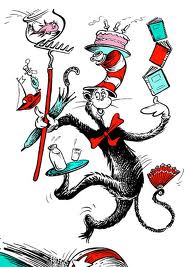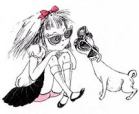I recently stumbled across this very valuable and up to date list of 30 children’s book publishers–big and small–who will accept unsolicited, unagented manuscripts. So if your New Year’s resolution is to send out that manuscript, here’s a good place to start.
Author: Amy MacDonald
The Way a Crow

The way a crow
shook down on me
a dust of snow
from a hemlock tree
has given my heart
a change of mood
and saved some part
of a day I had rued.
–Robert Frost
This poem popped into my head one day when I’d gone skiing through a hemlock forest after a really bad morning. And it really and truly did give my heart a change of mood. Thank you, Robert Frost.
Snow joke…’s no joke
Believe It or Not

Faith Worster was in second grade when I signed this copy of Rachel Fister for her. This month–all grown up now– she published her OWN children’s book, called Chronicles of Magic. Here she is signing her own book recently.
” I wanted to thank you for helping inspire me to write, ” she tweeted to me.
Has anyone out there been inspired to do some writing of their own by meeting a ‘real author’? If so, maybe you will follow in Faith’s footsteps and become a ‘real author.’ Just be sure to let the author know. It’s a real thrill to hear stories like this!

Um, First You Have to Write It: 5 Quick Tips for Picture Books
“I have a great idea for a picture book. How can I get it published?”
If I had a dollar for every time someone’s asked me that question, I could probably pay for the dental work to repair the teeth it’s caused me to grind into dust.
I can understand beginners asking the question. They assume that because picture books are short, writing them is easy. A happy hour tapping on a keyboard, a little consult with the Rhyming Dictionary, a quick pass through Spellcheck, and voila! Ready to send to a publisher.
Less easy to understand is a professional penning a 1,000-word article called “How to Write a Picture Book” which contains only 7 words actually dealing with the topic of writing, and they are these:
“You need to actually write the book.”
Really? You do? But instead of telling them how, the author leapfrogs over this to more fun stuff like finding an agent, illustrating your story, and promoting your published book. Hard as it may be to accept, aspiring authors are probably better served learning how to “actually write” a picture book before anyone goes stoking their fantasies about fending off all the publishers clamoring to sign them. So in that spirit I offer a few “actual writing” tips for picture books:
1. Think visually. By definition, picture books are a visual medium. Pick a concept or story line that’s illustratable. Someone thinking about something–moping, fearing, wishing— is not easily illustrated. The havoc a certain Cat can wreak on a home is. 
2. Make sure there is some kind of tension. At the very least, there must be a need to find out what comes next. Young readers–just like old readers– must have a reason to keep turning pages. The driving force behind your story can be as complicated as finding out who stole the bear’s hat, or if the Cat can put the house back in order before Mother returns. Or it can be as simple as just wanting to feel the exquisite comfort of bidding good night to every single thing in the Great Green Room as night falls.
3. Make that tension grow. Is it a humorous book? The humor should get funnier–the chaos caused by the mouse, or the Cat–should increase page by page. Is it a scary book? The monsters should get scarier on each page. A quest for something? The obstacles get harder and harder.
4. Give your character some character! 
Think of the great children’s book stars:Eloise, Madeleine, Olivia, Frog and Toad, Max, Winnie the Pooh, Eeyore, the Cat in the Hat. They all have unforgettable personalities. You should be able to describe your main character in one or two adjectives: feisty, stubborn, self-pitying, irrepressible, mono-maniacal…
5. Make sure the ending is satisfying. Max comes home to find…  ….his supper is still warm. Your readers should say “Aaahh” when they come to the end. You’ve given them what they wanted, but not necessarily the way they expected it.
….his supper is still warm. Your readers should say “Aaahh” when they come to the end. You’ve given them what they wanted, but not necessarily the way they expected it.
Your idea for a story has all those potential things–hurrah! Of course, you still have to sit down and “actually write” it. Sorry, but you do. Can’t help you with that part. But when you’re done with the writing, get back to me; then we can talk about agents and illustrators, publishers and promotion and Pulitzer Prizes.
Kennedy’s Death: The Day Before
I was lucky enough to be invited to participate in an event at Symphony Space in New York called “Nov. 21: The Day Before” which asked artists to create work around the idea of the day BEFORE Kennedy’s assassination. Here’s the short essay I wrote, from the perspective of the 12-year-old I then was. (NY Times review of event.)
The photo is of me with two other artists who participated in the event: Sabrina Small (center) who created artwork to accompany my reading; and Mimi Herman, poet.
Why I Don’t Write Poems
In honor of National Poetry month, I bravely post here my very first, and likely last, poem, inspired by Richard Blanco’s wonderful poem for the President’s inauguration, <a title=”One Today” href=”http://www.richard-blanco.com/inaugural-poet/one-today.php”>One Today</a>, and by his equally wonderful reading in Portland earlier this month.
Why I Don’t Write Poems
When it came time to pen
his poem about America, fellow
Mainer Richard Blanco wrote about
a school bus “pencil yellow.”
No one asked me to write that ode
but if they had
it would have been a
a school bus “mustard-yellow.”
And that is why
Richard Blanco is a poet
and I…
‘m not.
Why Read Fiction?
“It is difficult to get the news from poems, yet men die miserably every day for lack of what is found there.” –William Carlos Williams
In a hard economic world, where classrooms at every level seem increasingly designed to be vocational training grounds and little else, where the three RRR’s (which included reading and writing) are being replaced by the hot new acronym STEM, where the new Common Core language arts standards insist on a shift away from fiction into non-fiction (and by non-fiction they include maps, and menus and manuals), in a world where the man who spearheaded the Common Core notes that employers are not apt to ask someone to produce a “compelling account of his childhood” before tackling that market analysis…In such a world, why should fiction be a part of a child’s education?
Because fiction, as William Carlos Williams notes, provides life-giving sustenance:
It can be a friend when we’re lonely, a refuge when we’re overwhelmed. And children are often lonely and often overwhelmed.
It supplies the pleasure of recognition—wow, someone put my own thoughts into words—as well as wonder at the new: who knew?
It takes us inside ourselves. It takes us outside ourselves.
It makes us explore, as nothing else can, the most intriguing question of all: What if?
It makes the strange familiar—we don’t ever have to have lived on a farm to know exactly what Wilbur and Charlotte’s barn looks and feels and smells like.
And it makes the familiar strange: a boy’s bedroom becomes a kingdom of wild things.
It makes us stretch our minds and use our imagination and ask uncomfortable questions. It comforts, inspires and reassures. It scares and stimulates.
Absolutely, it’s important to be able to read maps, and menus, and manuals. And market analyses. It’s also important to be able to journey to where the wild things are, and back home again.
Email of the Week
My husband Jim was curious where you learned the math trick that Aunt Mattie and Uncle Philbert talk about in the book [No More Nasty, p. 91]? Do you know if it has an official name? He was curious how the 3-digit method works. My husband is good with numbers and my daughter was amazed that she could put the numbers in the calculator as quickly as her dad could solve them on paper using this new method. Any information would be appreciated.
Thank you, Kim
Dear Kim,
The official name is “Multi-Qwik, Uncle Philbert’s Patented Homework Reducing Time Saving Three Step Multiple Digit Multiplication Method.” Really. It was invented by a friend of mine when he was in grade school, and it really does work. He figured out that he could do his math homework quicker that way, and he actually DID get in trouble with his teacher for doing his math this way, instead of how the book said to do it.
Sometimes truth is stranger than fiction. And it really is patented.
Yours,
Amy MacDonald
P.S. Click here for Classroom Activities related to the Multi-Qwik math trick.
Nice Review of “Big Front Tooth”
Nice Review of “Big Front Tooth”
In the Daily Mail (gulp). Huge circulation but not my favorite newspaper.
Review of “LIttle Beaver and the Big Front Tooth”
In the Daily Mail (gulp). Huge circulation but not my favorite newspaper.



